On the trail of the Ancient Greeks
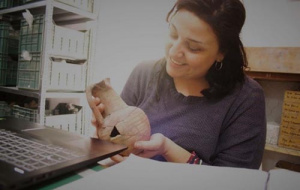
In the storage rooms of the Archaeological Museum of Villa Arbusto in Ischia
Graduate OMT Travel Fund Report – Marcella Giobbe, DPhil candidate in Classical Archaeology
On the trail of the Ancient Greeks in the west: back to Ischia (Italy)
April-May 2019
My DPhil project focuses on the study of pottery production and technology from the 10th to the 7th century BC Campania Region (Italy). Ceramics when meaningfully constituted and employed as part of social strategies, are informative of social practices relating to the maintenance and reproduction of social groups, power relations and the construction of identities.
By combining pottery classification with ceramic thin section petrography and compositional analysis (on both ceramics and local raw clays), my results will significantly impact current discussion on the first instances of the Greek Colonisation of Southern Italy. I am conducting a materials-based assessment of the shift from the “Pre-Colonial to the Colonial” period (10th to 7th BC) on an unprecedented scale, providing crucial insights on the relationship between the Greeks and the local Campanian populations.
The access to the archaeological assemblages from selected sites (Pithekoussai, Cumae, Capuae and Pontecagnano) has been a key long-term challenge and required skilful and patient negotiation with local and national institutions.
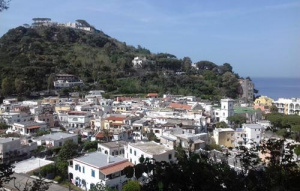
The village of Lacco Ameno (Ischia). On the hill in the background, the Greek Acropolis of Pithekoussai. Left to the Acropolis, the San Montano Valley
Among the most crucial steps to overcome has been the permit to study the pottery from the Necropolis of San Montano in Pithekoussai (Ischia), despite no prior project having had complete access to it for more than 50 years. The island is key to the research as it has been defined as the first Greek permanent establishment on the Tyrrhenian Sea, before the foundation of Cumae, defined by Strabo as the first Greek colony (apokia) in the West.
I journeyed from Oxford to Naples in April with a luggage of books and photographic equipment. Ischia is a very touristy island and the archaeological museum of Villa Arbusto (where the material is stored) is located in a small village called Lacco Ameno. The island is famous for thermal baths, nice beaches and good wine, but the public transports are definitely not a highlight.
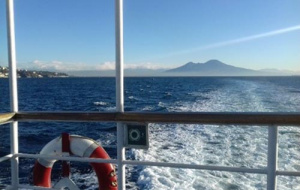
Early morning travels on the ferry to Ischia
I realised that living in Naples most of the time would have been cheaper than renting a room on the island. Therefore, I decided mostly to commute daily to the island, according also to the necessity and the timetable of the museum staff. I had access to the storage rooms from 9am to 3.30pm, Monday to Friday.
I organised the work into stages. The material has been divided into groups according to chronology, pottery class (fine or coarse) and shape. I have been undertaking a small typological analysis of the vessels according to shape, decoration and clay fabric characteristics.
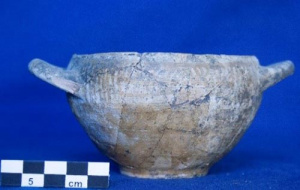
A vessel from the San Montano Necropolis assemblage
In addition, a database was created considering also further insights about pottery technology (such as raw material use, manufacturing techniques, firing temperature, quality, surface treatment). From this first macroscopic study around 100 samples will be selected for the petrographic and chemical analysis (that will take place next year between Oxford and Athens). The first results highlighted interesting patterns about local manufacturing techniques and craft tradition through time.
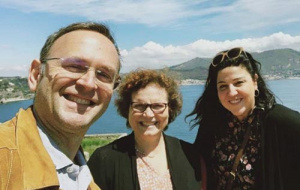
From left to right: Prof. D’Acunto/ Università ‘L’Orientale’ of Naples, Prof. Lemos/University of Oxford and I, in visit at the Archaeological Museum of the Phlegraean Fields in Baiae
Furthermore, while in Naples, I had an official meeting with my supervisor and some of the most eminent scholars working in Campania (B. d’Agostino/ Emeritus Professor of Greek Archaeology of the University ‘l’Orientale’ of Naples; Dr. T. Cinquantaquattro/ General Superintendent of Naples, Ministero dei Beni Culturali; Prof. M. D’Acunto/Associate Professor of Greek Archaeology; L. Cerchiai/ Professor of Etruscolgy and Italian Archaeology, University of Salerno). Furthermore, I visited the local museums where ceramic from Pithekoussai is exposed, I participated to seminar talks and I attended to few conferences on Greek Archaeology and Etruscology.
Travelling is an essential part of the project as the method I adopted requires the direct study of the archaeological material from selected sites. The OMT Travel fund has provided a crucial help in financially supporting this first visit to Italy. This travel has been an important step for my project and a great opportunity to directly engage with the material and create the basis for valuable connections that materialised into useful research collaborations.
Find out more about the range of travel grants and scholarships available to assist Univ students on our Travel Grants page or read further travel reports.
Published: 21 August 2019
Explore Univ on social media
